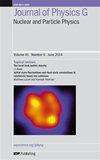分段BGO探测器在LUNA的辐射捕获研究进展
IF 3.4
3区 物理与天体物理
Q2 PHYSICS, NUCLEAR
Journal of Physics G: Nuclear and Particle Physics
Pub Date : 2023-02-06
DOI:10.1088/1361-6471/acb961
引用次数: 6
摘要
低能核天体物理学中带电粒子反应的研究需要高灵敏度,这可以通过高效率和低背景的探测装置来实现,以获得对恒星场景感兴趣的能量区域的精确测量。高效全吸收光谱学是研究辐射俘获反应的一种成熟而有力的工具,特别是如果结合地下核天体物理实验室(LUNA)获得的几个数量级的宇宙背景缩小。我们介绍了LUNA上铋锗氧化物探测器(BGO)探测装置的最新改进,旨在减少高能背景并提高求和探测效率。正如我们在17O(p,gamma)18F反应的65 keV共振(Ex = 5672 keV)的首次直接测量的背景下所演示和讨论的那样,新的设计结果增强了BGO设置的灵敏度。此外,我们还展示了BGO检测器的两个应用,这些应用利用了它的分割。在复杂的伽马射线级联的情况下,例如18F中Ex = 5672 keV的去激发,BGO分割允许识别和抑制模拟感兴趣的和峰的波束诱导的背景信号。我们展示了这种探测器的另一种新应用,即对β +不稳定产物核的反应进行现场活化测量,例如14N(p, γ)15O反应。本文章由计算机程序翻译,如有差异,请以英文原文为准。
Advances in radiative capture studies at LUNA with a segmented BGO detector
Studies of charged-particle reactions for low-energy nuclear astrophysics require high sensitivity, which can be achieved by means of detection setups with high efficiency and low backgrounds, to obtain precise measurements in the energy region of interest for stellar scenarios. High-efficiency total absorption spectroscopy is an established and powerful tool for studying radiative capture reactions, particularly if combined with the cosmic background reduction by several orders of magnitude obtained at the Laboratory for Underground Nuclear Astrophysics (LUNA). We present recent improvements in the detection setup with the Bismuth Germanium Oxide (BGO) detector at LUNA, aiming to reduce high-energy backgrounds and to increase the summing detection efficiency. The new design results in enhanced sensitivity of the BGO setup, as we demonstrate and discuss in the context of the first direct measurement of the 65 keV resonance (Ex = 5672 keV) of the 17O(p,gamma)18F reaction. Moreover, we show two applications of the BGO detector, which exploit its segmentation. In case of complex gamma-ray cascades, e.g. the de-excitation of Ex = 5672 keV in 18F, the BGO segmentation allows to identify and suppress the beam-induced background signals that mimic the sum peak of interest. We demonstrate another new application for such a detector in form of in-site activation measurements of a reaction with beta+ unstable product nuclei, e.g., the 14N(p,gamma)15O reaction.
求助全文
通过发布文献求助,成功后即可免费获取论文全文。
去求助
来源期刊
CiteScore
7.60
自引率
5.70%
发文量
105
审稿时长
1 months
期刊介绍:
Journal of Physics G: Nuclear and Particle Physics (JPhysG) publishes articles on theoretical and experimental topics in all areas of nuclear and particle physics, including nuclear and particle astrophysics. The journal welcomes submissions from any interface area between these fields.
All aspects of fundamental nuclear physics research, including:
nuclear forces and few-body systems;
nuclear structure and nuclear reactions;
rare decays and fundamental symmetries;
hadronic physics, lattice QCD;
heavy-ion physics;
hot and dense matter, QCD phase diagram.
All aspects of elementary particle physics research, including:
high-energy particle physics;
neutrino physics;
phenomenology and theory;
beyond standard model physics;
electroweak interactions;
fundamental symmetries.
All aspects of nuclear and particle astrophysics including:
nuclear physics of stars and stellar explosions;
nucleosynthesis;
nuclear equation of state;
astrophysical neutrino physics;
cosmic rays;
dark matter.
JPhysG publishes a variety of article types for the community. As well as high-quality research papers, this includes our prestigious topical review series, focus issues, and the rapid publication of letters.

 求助内容:
求助内容: 应助结果提醒方式:
应助结果提醒方式:


